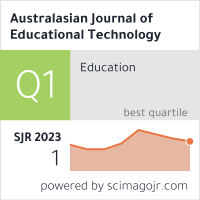Exploring the specification of educational compatibility of virtual reality within a technology acceptance model
DOI:
https://doi.org/10.14742/ajet.7338Keywords:
educational compatibility, attitude, perceived usefulness, virtual reality, technology acceptance modelAbstract
This study investigated the specification of educational compatibility within a technology acceptance model (TAM) suited to engaging educational technologies. Attitudes towards virtual reality (VR) for learning was used to test the experimental model. One hundred and seventy-nine valid survey responses were collected from 517 potential participants with the majority from first-year university students. The independent variables were educational compatibility, cognitive engagement, social influence, system attributes, perceived anxiety and facilitating conditions. Exploratory factor analysis showed that educational compatibility and attitude were collinear, and therefore were combined into one construct. Confirmatory factor analysis indicated that the combined educational compatibility-attitude construct and perceived usefulness were not discriminant. Two structural models were therefore compared: one where educational compatibility-attitude items were incorporated within perceived usefulness, and another where educational compatibility-attitude items were excluded entirely. The results showed that incorporating educational compatibility-attitude items within perceived usefulness affected the influence of cognitive engagement and system attributes on perceived usefulness, though overall model power was unchanged. The results suggested that (a) educational compatibility and attitude could be redundant, and (b) incorporating educational compatibility into perceived usefulness may help specify educationally focused TAMs.
Implications for practice or policy:
- Researchers may regard educational compatibility and attitude to be redundant and exclude them from TAMs as separate constructs.
- Researchers could consider tailoring the perceived usefulness construct to make it more specific to the educational context, for example by including one or more educational compatibility items.
Downloads
Metrics
Downloads
Published
How to Cite
Issue
Section
License
Copyright (c) 2022 Andrew Kemp, Edward Palmer, Peter Strelan, Helen Thompson

This work is licensed under a Creative Commons Attribution-NonCommercial-NoDerivatives 4.0 International License.
Articles published in the Australasian Journal of Educational Technology (AJET) are available under Creative Commons Attribution Non-Commercial No Derivatives Licence (CC BY-NC-ND 4.0). Authors retain copyright in their work and grant AJET right of first publication under CC BY-NC-ND 4.0.
This copyright notice applies to articles published in AJET volumes 36 onwards. Please read about the copyright notices for previous volumes under Journal History.



